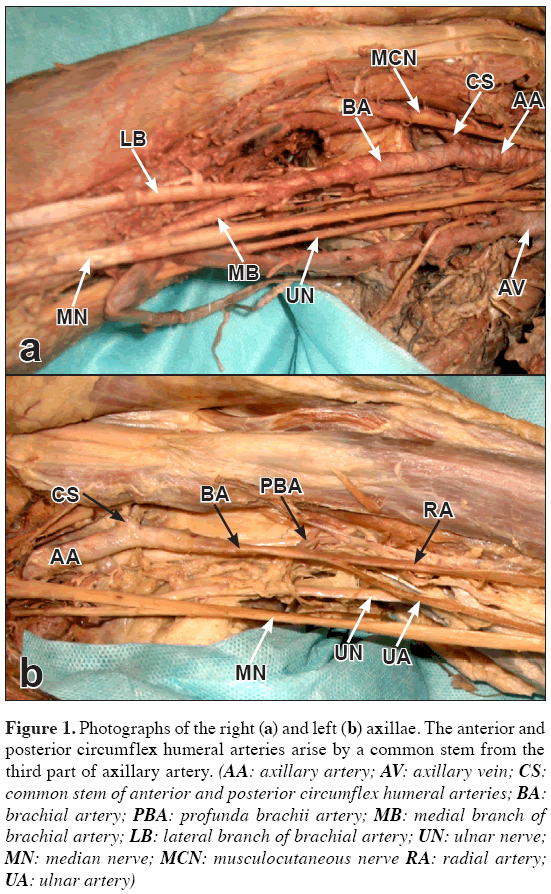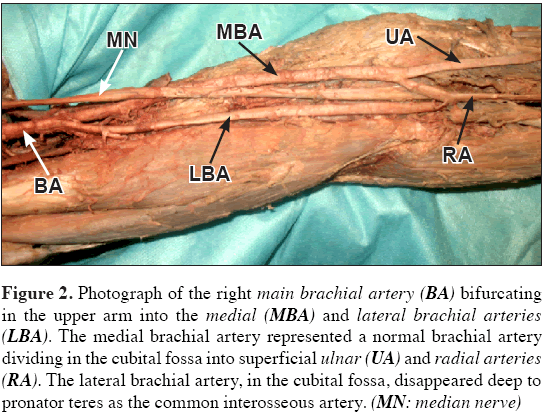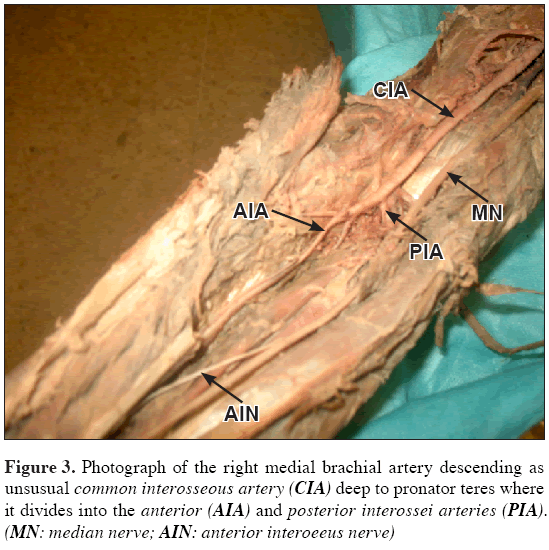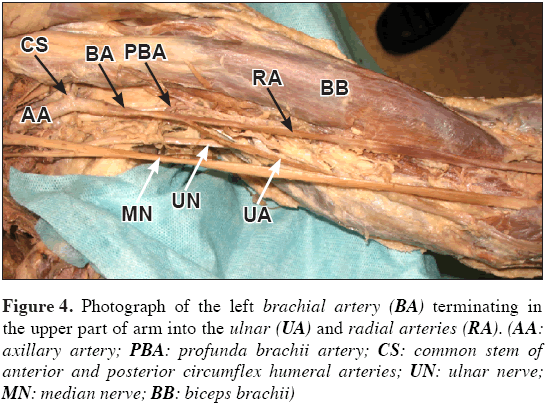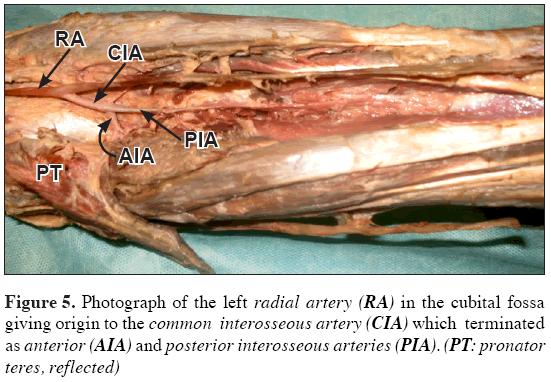Bilateral variations in the branching pattern of brachial artery
Adib A. Aughsteen1*, Hasan M. Hawamdeh2, Muzahim Al-Khayat3
1Department of Anatomy and Histology,College of Medicine, Hawler Medical University, Erbil, Iraq
2Departments of Pediatric and Community Medicine Faculty of Medicine, Hashemite University, Zarqa, Jordan.
3Departments of Pediatric and Community Medicine Faculty of Medicine, Surgery, Hashemite University, Zarqa, Jordan.
- *Corresponding Author:
- Dr. Adib A. Aughsteen (MBChB, M Med Sci, PhD)
Department of Anatomy and Histology, College of Medicine, Hawler Medical University, Erbil, Iraq.
Tel: +964 750 1394455
E-mail: adib@go.com.jo
Date of Received: May 28th, 2011
Date of Accepted: August 11th, 2011
Published Online: October 6th, 2011
© IJAV. 2011; 4: 167–170.
[ft_below_content] =>Keywords
vascular anatomy, cadaver, male, variation, brachial artery
Introduction
The recognition and documentation of developmental variation in the course, distribution, and branching pattern of the arteries of upper limb is highly significant in the angiographic and surgical practice. The frequent existence of upper limb vascular variations is attributed to the complex and multiple sites of their embryonic development [1–3]. Variations of the upper limb arteries are rather common and have been reported since the 17th century [3]. The first systematic description and classification of these variations was published in 1844 by the Quain’s review of literature and analysis of cadaver dissection and angiographic studies [4]. Several gross anatomical and radiographic reports have been published on various unusual branching and distribution patterns of upper limb arteries [5–10]. However, many conflicts and frustration in expressing the terminology and course of these variations are still faced. In a previous report [11], a duplicated incomplete superficial palmar arch solely arising from the ulnar artery was reported. The present report demonstrates bilateral variation in the course and branching pattern of brachial artery in the same cadaver.
Case Report
Developmental variations in the course and branching pattern of the right and left brachial arteries were observed and recorded in a 70-year-old male cadaver during routine cadaver dissection in the practical sessions of the medical students of Hashemite University, Jordan. The skin and fascia of the right and left upper limbs were completely dissected, and the neurovascular bundles of the axillae and the whole limbs were clearly explored. The course of the arteries and their branches were thoroughly traced and the observed anatomical variations were recorded and photographed using a Canon PowerShot A620 digital camera.
The axillary artery in both upper limbs had normal anatomical course and branching pattern with the branches of brachial plexus cords normally distributed around it. However, the anterior and posterior circumflex humeral arteries of the 3rd part of axillary artery in both limbs arose from a common trunk (Figure 1).
Figure 1: Photographs of the right (a) and left (b) axillae. The anterior and posterior circumflex humeral arteries arise by a common stem from the third part of axillary artery. (AA: axillary artery; AV: axillary vein; CS: common stem of anterior and posterior circumflex humeral arteries; BA: brachial artery; PBA: profunda brachii artery; MB: medial branch of brachial artery; LB: lateral branch of brachial artery; UN: ulnar nerve; MN: median nerve; MCN: musculocutaneous nerve RA: radial artery; UA: ulnar artery)
In the right upper limb, the principle brachial artery descended from axillary artery with median nerve lying anteromedial. The principle brachial artery, few centimeters below the origin of profunda brachii artery, bifurcated into the medial and lateral brachial arteries (Figure 2).
Figure 2: Photograph of the right main brachial artery (BA) bifurcating in the upper arm into the medial (MBA) and lateral brachial arteries (LBA). The medial brachial artery represented a normal brachial artery dividing in the cubital fossa into superficial ulnar (UA) and radial arteries (RA). The lateral brachial artery, in the cubital fossa, disappeared deep to pronator teres as the common interosseous artery. (MN: median nerve)
The medial brachial artery was larger in size, crossed anteriorly by the median nerve from medial to lateral side, and descended under the deep fascia representing the usual brachial artery. In the cubital fossa and deep to bicipital aponeurosis, it divided into the superficial ulnar and radial arteries (Figure 2). The ulnar and radial arteries descended in the forearm under the deep fascia and superficial to the flexor muscles, however and unexpectedly, the radial artery gave origin to the common interosseous artery passing deep to pronator teres where divided into anterior and posterior interosseous arteries (Figure 3). The superficial palmar arch of the right palm was unique and was represented by duplicated incomplete arches solely originated from the ulnar artery. This variation was documented in a previously published report [11].
The smaller right lateral brachial artery descended in the arm posterolateral to the median nerve and gave origin to all branches normally arisen from a usual brachial artery. In the cubital fossa and lateral to the median nerve, it descended deep to pronator teres as the common interosseous artery where it divided into the anterior and posterior interosseous arteries (Figure 3).
In the left upper limb, the brachial artery was smaller in size, and a little below the origin of profunda brachii artery, it divided into the ulnar and radial arteries (Figure 4). The course of the ulnar and radial arteries was as usual in the forearm, however and unexpectedly, the radial artery gave origin to the common interosseous artery which descended deep to pronator teres and divided into the anterior and posterior interosseous arteries (Figure 5). The left superficial palmar arch showed no variation in the pattern of formation.
Figure 4: Photograph of the left brachial artery (BA) terminating in the upper part of arm into the ulnar (UA) and radial arteries (RA). (AA: axillary artery; PBA: profunda brachii artery; CS: common stem of anterior and posterior circumflex humeral arteries; UN: ulnar nerve; MN: median nerve; BB: biceps brachii)
Discussion
The rapid advance in the techniques of microvascular and reconstructive surgery of the upper limbs arteries warrants a careful observation and record of all varieties of developmental variations of upper limb arteries. The large body of previously published anatomical and angiographic reports on the upper limb vascular variations reflects the complexity and diversity in the origins of their development.
The embryogenesis of upper limb arteries is rather complicated as multiple primitive capillary plexuses contribute to their formation. The initial upper limb vascular bud is a single trunk representing the subclavian artery which arises from the 7th intersegmental artery [1,3,12]. Initially, the axillary and brachial artery representing the primordial axial artery passes into the forearm and ends into the deep capillary plexus of the developing hand. The distal part of the axial vessel eventually represents the anterior interosseous artery and the deep palmar arch. A branch arising from the main trunk passes dorsally between the ulna and radius representing the posterior interosseous artery followed by another small branch, the median artery which accompanies the median nerve and terminates in the superficial capillary plexus of the hand. The ulnar and radial arteries are the latest arteries to appear with the radial artery arising more proximally. Meanwhile, the radial artery assumes a new connection with the brachial artery at the level of the origin of ulnar artery, and the course and distribution of brachial artery with its two terminal branches eventually acquire their final form [1,3,12]. Therefore, it seems likely that all variant forms of brachial artery can be either attributed to the genetic racial factor or to the derangement in the development of the primordial arterial axis of the upper limb occurring during conception.
In the present report, multiple variations in the branching pattern and course of both right and left brachial arteries were documented. In the right upper limb, the common interosseous artery was continued from an unusual lateral brachial artery, while the superficial ulnar and radial arteries arose from the medial brachial artery. On the other hand, the left brachial artery bifurcated high in the arm into the ulnar and radial arteries. The left common interosseous artery strangely and unexpectedly originated from the radial artery. Moreover, the superficial palmar arch of the right palm was represented by a duplicated incomplete arches originated from ulnar artery with no contribution from radial artery [11].
Similar reports have been published by Nakatani et al. [13], Durgun et al. [14], Yoshinaga et al. [15] and Cherukupalli et al. [16], however the reported branching pattern of the brachial arteries was completely different from our report. Tohono et al. [17] have reported a high origin of the left ulnar artery arising from brachial artery in the upper part of arm, while the brachial artery branched into radial and common interosseus arteries in the cubital fossa. Jurjus et al. [18], Wozniak et al. [19] and DʼCosta et al. [20] have reported brachial artery variations similar to our present findings. Baral et al. [21] reported multiple vascular variations in the axilla, forearm and palm. Similar to our finding, the common interosseous artery was originated from the radial artery. In summary, the present report provides additional information on the branching and distribution pattern of the brachial artery. Documentation of these variations is highly significant for the radiologic diagnostic techniques and for the surgeons while performing traumatic vascular repair, by-pass procedures, and reconstructive plastic surgery.
Acknowledgement
The study was supported by a research grant from the Deanship of Scientific Research, Hashemite University, Zarqa, Jordan. Our thanks go to Raad Mashaqbeh and Anas Ababneh for their help and assistance in dissection and photography.
References
- Williams PL, Warwick R, Dyson M, Bannister LH, eds. Gray’s Anatomy. 37th Ed., New York, Churchill Livingstone, 1989; 318–319.
- Icten N, Sullu Y, Tuncer I. Variant high-origin radial artery: a bilateral case. Surg Radiol Anat. 1996; 18: 63–66.
- Ciervo A, Kahn M, Pangilinan AJ, Dardik H. Absence of the brachial artery: report of a rare human variation and review of upper extremity arterial anomalies. J Vasc Surg. 2001; 33: 191–194.
- Quain R. The anatomy of the arteries of the human body, and its applications to pathology and operative surgery. London, Taylor and Walter. 1844; 235–271.
- Sargon MF, Tanyeli E, Surucu HS, Yazar F, Arifoglu Y. A complicated variation of the upper extremity vascularisation. Kaibogaku Zasshi. 1996; 71: 211–214.
- Celik HH, Gormus G, Aldur MM, Ozcelik M. Origin of the radial and ulnar arteries: variations in 81 arteriograms. Morphologie. 2001; 85: 25–27.
- Pelin C, Zagyapan R, Mas N, Karabay G. An unusual course of the radial artery. Folia Morphol (Warsz). 2006; 65: 410–413.
- Yalcin B, Kocabiyik N, Yazar F, Kirici Y, Ozan H. Arterial variation of the upper extremities. Anat Sci Int. 2006; 81: 62–64.
- Bataineh ZM, Al-Hussain SM, Moqattash ST. Complex neurovascular variation in one upper limb. Ital J Anat Embryol. 2007; 112: 37–44.
- Dartnell J, Sekaran P, Ellis H. The superficial ulnar artery: incidence and calibre in 95 cadaveric specimens. Clin Anat. 2007; 20: 929–932.
- Aughsteen AA. Case report of a new variant of double incomplete superficial palmar arch. Anat Sci Int. 2011 May 11. [Epub ahead of print]
- Rodriguez-Niedenfuhr M, Burton GJ, Deu J, Sanudo JR. Development of the arterial pattern in the upper limb of staged human embryos: normal development and anatomic variations. J Anat. 2001; 199: 407–417.
- Nakatani T, Tanaka S, Mizukami S. Superficial brachial arteries observed in bilateral arms. Kaibogaku Zasshi 1996; 71: 308–312.
- Durgun B, Yucel AH, Kizilkanat ED, Dere F. Multiple arterial variation of the human upper limb. Surg Radiol Anat. 2002; 24 (2): 125–128.
- Yoshinaga K, Tanii I, Kodama K. Superficial brachial artery crossing over the ulnar and median nerves from posterior to anterior: embryological significance. Anat Sci Int. 2003; 78: 177–180.
- Cherukupalli C, Dwivedi A, Dayal R. High bifurcation of brachial artery with acute arterial insufficiency: a case report. Vasc Endovascular Surg. 2007; 41: 572–574.
- Tohno S, Tohno Y, Yamaoka J, Yamaguchi S, Yamaguchi T, Yamane T. Anomaly of the ulnar artery arising from the brachial artery. Kaibogaku Zasshi. 1995; 70: 31–34.
- Jurjus A, Sfeir R, Bezirdjian R. Unusual variation of the arterial pattern of the human upper limb. Anat Rec. 1986; 215: 82–83.
- Wozniak W, Bruska M, Markowski M. A case of high origin of the common interosseous artery. Folia Morphol (Warsz). 1998; 57: 389–391.
- D’Costa S, Shenoy BM, Narayana K. The incidence of a superficial arteria; pattern in the human upper extremities. Folia Morphol (Warsz). 2004; 63: 459–463.
- Baral P, Vijayabhaskar P, Roy S, Kumar S, Ghimire, Shrestha U. Multiple arterial anomalies in upper limb. Kathmandu Univ Med J (KUMJ). 2009; 7: 293–297.
Adib A. Aughsteen1*, Hasan M. Hawamdeh2, Muzahim Al-Khayat3
1Department of Anatomy and Histology,College of Medicine, Hawler Medical University, Erbil, Iraq
2Departments of Pediatric and Community Medicine Faculty of Medicine, Hashemite University, Zarqa, Jordan.
3Departments of Pediatric and Community Medicine Faculty of Medicine, Surgery, Hashemite University, Zarqa, Jordan.
- *Corresponding Author:
- Dr. Adib A. Aughsteen (MBChB, M Med Sci, PhD)
Department of Anatomy and Histology, College of Medicine, Hawler Medical University, Erbil, Iraq.
Tel: +964 750 1394455
E-mail: adib@go.com.jo
Date of Received: May 28th, 2011
Date of Accepted: August 11th, 2011
Published Online: October 6th, 2011
© IJAV. 2011; 4: 167–170.
Abstract
Multiple bilateral variations in the course and branching pattern of the brachial arteries were recorded in a 70-year-old male cadaver during the routine dissection carried in the practical sessions of the medical students of Hashemite University in Jordan.
The right main brachial artery divided in the upper third of arm into the medial and lateral brachial branches. The medial brachial artery descended as the usual brachial artery with the median nerve crossing anteriorly from the medial to lateral side. In the cubital fossa, under the bicipital aponeurosis, it ended by dividing into the superficial ulnar and radial arteries. The lateral brachial artery descended posterolateral to the median nerve and continued in the cubital fossa as the common interosseous artery where it divided into the anterior and posterior interosseous arteries deep to pronator teres.
The left brachial artery was smaller in size, and bifurcated high in the arm into the superficial radial and ulnar arteries. Unexpectedly, the left radial artery in the cubital fossa, gave origin to the common interosseous artery, which descended deep to pronator teres where it divided into the anterior and posterior interosseous arteries. These variations are thoroughly discussed and compared with previously published findings, and their clinical significances are highlighted.
Keywords
vascular anatomy, cadaver, male, variation, brachial artery
Introduction
The recognition and documentation of developmental variation in the course, distribution, and branching pattern of the arteries of upper limb is highly significant in the angiographic and surgical practice. The frequent existence of upper limb vascular variations is attributed to the complex and multiple sites of their embryonic development [1–3]. Variations of the upper limb arteries are rather common and have been reported since the 17th century [3]. The first systematic description and classification of these variations was published in 1844 by the Quain’s review of literature and analysis of cadaver dissection and angiographic studies [4]. Several gross anatomical and radiographic reports have been published on various unusual branching and distribution patterns of upper limb arteries [5–10]. However, many conflicts and frustration in expressing the terminology and course of these variations are still faced. In a previous report [11], a duplicated incomplete superficial palmar arch solely arising from the ulnar artery was reported. The present report demonstrates bilateral variation in the course and branching pattern of brachial artery in the same cadaver.
Case Report
Developmental variations in the course and branching pattern of the right and left brachial arteries were observed and recorded in a 70-year-old male cadaver during routine cadaver dissection in the practical sessions of the medical students of Hashemite University, Jordan. The skin and fascia of the right and left upper limbs were completely dissected, and the neurovascular bundles of the axillae and the whole limbs were clearly explored. The course of the arteries and their branches were thoroughly traced and the observed anatomical variations were recorded and photographed using a Canon PowerShot A620 digital camera.
The axillary artery in both upper limbs had normal anatomical course and branching pattern with the branches of brachial plexus cords normally distributed around it. However, the anterior and posterior circumflex humeral arteries of the 3rd part of axillary artery in both limbs arose from a common trunk (Figure 1).
Figure 1: Photographs of the right (a) and left (b) axillae. The anterior and posterior circumflex humeral arteries arise by a common stem from the third part of axillary artery. (AA: axillary artery; AV: axillary vein; CS: common stem of anterior and posterior circumflex humeral arteries; BA: brachial artery; PBA: profunda brachii artery; MB: medial branch of brachial artery; LB: lateral branch of brachial artery; UN: ulnar nerve; MN: median nerve; MCN: musculocutaneous nerve RA: radial artery; UA: ulnar artery)
In the right upper limb, the principle brachial artery descended from axillary artery with median nerve lying anteromedial. The principle brachial artery, few centimeters below the origin of profunda brachii artery, bifurcated into the medial and lateral brachial arteries (Figure 2).
Figure 2: Photograph of the right main brachial artery (BA) bifurcating in the upper arm into the medial (MBA) and lateral brachial arteries (LBA). The medial brachial artery represented a normal brachial artery dividing in the cubital fossa into superficial ulnar (UA) and radial arteries (RA). The lateral brachial artery, in the cubital fossa, disappeared deep to pronator teres as the common interosseous artery. (MN: median nerve)
The medial brachial artery was larger in size, crossed anteriorly by the median nerve from medial to lateral side, and descended under the deep fascia representing the usual brachial artery. In the cubital fossa and deep to bicipital aponeurosis, it divided into the superficial ulnar and radial arteries (Figure 2). The ulnar and radial arteries descended in the forearm under the deep fascia and superficial to the flexor muscles, however and unexpectedly, the radial artery gave origin to the common interosseous artery passing deep to pronator teres where divided into anterior and posterior interosseous arteries (Figure 3). The superficial palmar arch of the right palm was unique and was represented by duplicated incomplete arches solely originated from the ulnar artery. This variation was documented in a previously published report [11].
The smaller right lateral brachial artery descended in the arm posterolateral to the median nerve and gave origin to all branches normally arisen from a usual brachial artery. In the cubital fossa and lateral to the median nerve, it descended deep to pronator teres as the common interosseous artery where it divided into the anterior and posterior interosseous arteries (Figure 3).
In the left upper limb, the brachial artery was smaller in size, and a little below the origin of profunda brachii artery, it divided into the ulnar and radial arteries (Figure 4). The course of the ulnar and radial arteries was as usual in the forearm, however and unexpectedly, the radial artery gave origin to the common interosseous artery which descended deep to pronator teres and divided into the anterior and posterior interosseous arteries (Figure 5). The left superficial palmar arch showed no variation in the pattern of formation.
Figure 4: Photograph of the left brachial artery (BA) terminating in the upper part of arm into the ulnar (UA) and radial arteries (RA). (AA: axillary artery; PBA: profunda brachii artery; CS: common stem of anterior and posterior circumflex humeral arteries; UN: ulnar nerve; MN: median nerve; BB: biceps brachii)
Discussion
The rapid advance in the techniques of microvascular and reconstructive surgery of the upper limbs arteries warrants a careful observation and record of all varieties of developmental variations of upper limb arteries. The large body of previously published anatomical and angiographic reports on the upper limb vascular variations reflects the complexity and diversity in the origins of their development.
The embryogenesis of upper limb arteries is rather complicated as multiple primitive capillary plexuses contribute to their formation. The initial upper limb vascular bud is a single trunk representing the subclavian artery which arises from the 7th intersegmental artery [1,3,12]. Initially, the axillary and brachial artery representing the primordial axial artery passes into the forearm and ends into the deep capillary plexus of the developing hand. The distal part of the axial vessel eventually represents the anterior interosseous artery and the deep palmar arch. A branch arising from the main trunk passes dorsally between the ulna and radius representing the posterior interosseous artery followed by another small branch, the median artery which accompanies the median nerve and terminates in the superficial capillary plexus of the hand. The ulnar and radial arteries are the latest arteries to appear with the radial artery arising more proximally. Meanwhile, the radial artery assumes a new connection with the brachial artery at the level of the origin of ulnar artery, and the course and distribution of brachial artery with its two terminal branches eventually acquire their final form [1,3,12]. Therefore, it seems likely that all variant forms of brachial artery can be either attributed to the genetic racial factor or to the derangement in the development of the primordial arterial axis of the upper limb occurring during conception.
In the present report, multiple variations in the branching pattern and course of both right and left brachial arteries were documented. In the right upper limb, the common interosseous artery was continued from an unusual lateral brachial artery, while the superficial ulnar and radial arteries arose from the medial brachial artery. On the other hand, the left brachial artery bifurcated high in the arm into the ulnar and radial arteries. The left common interosseous artery strangely and unexpectedly originated from the radial artery. Moreover, the superficial palmar arch of the right palm was represented by a duplicated incomplete arches originated from ulnar artery with no contribution from radial artery [11].
Similar reports have been published by Nakatani et al. [13], Durgun et al. [14], Yoshinaga et al. [15] and Cherukupalli et al. [16], however the reported branching pattern of the brachial arteries was completely different from our report. Tohono et al. [17] have reported a high origin of the left ulnar artery arising from brachial artery in the upper part of arm, while the brachial artery branched into radial and common interosseus arteries in the cubital fossa. Jurjus et al. [18], Wozniak et al. [19] and DʼCosta et al. [20] have reported brachial artery variations similar to our present findings. Baral et al. [21] reported multiple vascular variations in the axilla, forearm and palm. Similar to our finding, the common interosseous artery was originated from the radial artery. In summary, the present report provides additional information on the branching and distribution pattern of the brachial artery. Documentation of these variations is highly significant for the radiologic diagnostic techniques and for the surgeons while performing traumatic vascular repair, by-pass procedures, and reconstructive plastic surgery.
Acknowledgement
The study was supported by a research grant from the Deanship of Scientific Research, Hashemite University, Zarqa, Jordan. Our thanks go to Raad Mashaqbeh and Anas Ababneh for their help and assistance in dissection and photography.
References
- Williams PL, Warwick R, Dyson M, Bannister LH, eds. Gray’s Anatomy. 37th Ed., New York, Churchill Livingstone, 1989; 318–319.
- Icten N, Sullu Y, Tuncer I. Variant high-origin radial artery: a bilateral case. Surg Radiol Anat. 1996; 18: 63–66.
- Ciervo A, Kahn M, Pangilinan AJ, Dardik H. Absence of the brachial artery: report of a rare human variation and review of upper extremity arterial anomalies. J Vasc Surg. 2001; 33: 191–194.
- Quain R. The anatomy of the arteries of the human body, and its applications to pathology and operative surgery. London, Taylor and Walter. 1844; 235–271.
- Sargon MF, Tanyeli E, Surucu HS, Yazar F, Arifoglu Y. A complicated variation of the upper extremity vascularisation. Kaibogaku Zasshi. 1996; 71: 211–214.
- Celik HH, Gormus G, Aldur MM, Ozcelik M. Origin of the radial and ulnar arteries: variations in 81 arteriograms. Morphologie. 2001; 85: 25–27.
- Pelin C, Zagyapan R, Mas N, Karabay G. An unusual course of the radial artery. Folia Morphol (Warsz). 2006; 65: 410–413.
- Yalcin B, Kocabiyik N, Yazar F, Kirici Y, Ozan H. Arterial variation of the upper extremities. Anat Sci Int. 2006; 81: 62–64.
- Bataineh ZM, Al-Hussain SM, Moqattash ST. Complex neurovascular variation in one upper limb. Ital J Anat Embryol. 2007; 112: 37–44.
- Dartnell J, Sekaran P, Ellis H. The superficial ulnar artery: incidence and calibre in 95 cadaveric specimens. Clin Anat. 2007; 20: 929–932.
- Aughsteen AA. Case report of a new variant of double incomplete superficial palmar arch. Anat Sci Int. 2011 May 11. [Epub ahead of print]
- Rodriguez-Niedenfuhr M, Burton GJ, Deu J, Sanudo JR. Development of the arterial pattern in the upper limb of staged human embryos: normal development and anatomic variations. J Anat. 2001; 199: 407–417.
- Nakatani T, Tanaka S, Mizukami S. Superficial brachial arteries observed in bilateral arms. Kaibogaku Zasshi 1996; 71: 308–312.
- Durgun B, Yucel AH, Kizilkanat ED, Dere F. Multiple arterial variation of the human upper limb. Surg Radiol Anat. 2002; 24 (2): 125–128.
- Yoshinaga K, Tanii I, Kodama K. Superficial brachial artery crossing over the ulnar and median nerves from posterior to anterior: embryological significance. Anat Sci Int. 2003; 78: 177–180.
- Cherukupalli C, Dwivedi A, Dayal R. High bifurcation of brachial artery with acute arterial insufficiency: a case report. Vasc Endovascular Surg. 2007; 41: 572–574.
- Tohno S, Tohno Y, Yamaoka J, Yamaguchi S, Yamaguchi T, Yamane T. Anomaly of the ulnar artery arising from the brachial artery. Kaibogaku Zasshi. 1995; 70: 31–34.
- Jurjus A, Sfeir R, Bezirdjian R. Unusual variation of the arterial pattern of the human upper limb. Anat Rec. 1986; 215: 82–83.
- Wozniak W, Bruska M, Markowski M. A case of high origin of the common interosseous artery. Folia Morphol (Warsz). 1998; 57: 389–391.
- D’Costa S, Shenoy BM, Narayana K. The incidence of a superficial arteria; pattern in the human upper extremities. Folia Morphol (Warsz). 2004; 63: 459–463.
- Baral P, Vijayabhaskar P, Roy S, Kumar S, Ghimire, Shrestha U. Multiple arterial anomalies in upper limb. Kathmandu Univ Med J (KUMJ). 2009; 7: 293–297.




